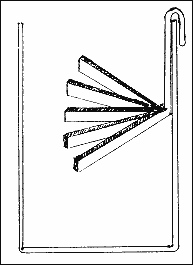The Crowfoot Battery
by Al Davies
Reprinted from "INSULATORS - Crown Jewels of the Wire", January 1970, page 7
The prime interest of the insulator collector, quite naturally, is the
kind, name, size, color, shape and other facts of historical interest
in connection with the object. The name insulator describes its
purpose, but of what use would it have been along with wire,
telegraph keys and sounders in the early day lines without electric
power?
Very limited sources of power were available for pioneer
telegraph lines and the primary source for far flung stations was the
gravity cell, commonly called the Crowfoot.
Telegraph systems were based on a closed circuit. This meant that
the armature on magnetic sounders was held against the core of
the electro-magnet by the passage of electricity through the wires
surrounding these cores. This required constant generation of
electricity.
When a message was to be sent the circuit was opened and the
station wanted called by a series of sounds caused by the tapping
of the armature against the cores of the electro-magnets.
The Crowfoot was particularly adapted to constant use as this
service delayed chemical decomposition. The cell could be made
with an open top glass jar about eight inches in diameter and ten
inches deep. The top electrode was suspended by hooking over
the edge of the jar and shaped like a hand with the fingers spread
apart; it was from this shape that the battery took its name. This furnished the positive pole and was of zinc.
The negative electrode was of copper and placed in the bottom
of the jar. Both electrodes were covered with a solution of blue
vitriol (copper sulphate).
To describe the solution correctly, "The copper electrode is
surrounded with crystals of copper sulphate and a weak solution
of zinc sulphate is added on top of the water above the zinc
electrode. " The difference in the specific gravities of the two
solutions keeps a blue line about midway between the electrodes;
this is the reason for the proper name of gravity cell.
Each cell generated about two volts, and a battery of these cells,
connected in series, was necessary for the generation of power
according to the location of the station. Your old time operator, in
addition to his other duties, had to be able to maintain this battery
of "crowfoots".
For many of our first telegraph lines these batteries were the only
source of electric power available.

Sketch of jar and zinc crowfoot by Bruce McDonald
| 